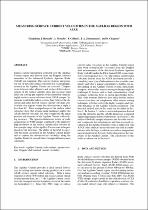JavaScript is disabled for your browser. Some features of this site may not work without it.
- ResearchSpace
- →
- Research Publications/Outputs
- →
- Conference Publications
- →
- View Item
| dc.contributor.author |
Rouault, Marjolaine J

|
|
| dc.contributor.author |
Mouche, A

|
|
| dc.contributor.author |
Collard, F

|
|
| dc.contributor.author |
Johannessen, JA

|
|
| dc.contributor.author |
Chapron, B

|
|
| dc.date.accessioned | 2011-09-05T12:40:20Z | |
| dc.date.available | 2011-09-05T12:40:20Z | |
| dc.date.issued | 2010-01 | |
| dc.identifier.citation | Rouault, M.J,, Mouche, A., Collard, F., et al. 2010. Measuring surface current velocities in the Agulhas region with ASAR. ESA's publication division. Frascati, January 2010, pp. 8pp | en_US |
| dc.identifier.uri | http://hdl.handle.net/10204/5140 | |
| dc.description | ESA's publication division. Frascati, January 2010 | en_US |
| dc.description.abstract | Surface current information collected over the Agulhas Current region and derived from the Doppler centroid anomalies of the Advanced Synthetic Aperture Radar (ASAR) are examined. The sources of errors and potential use of the radar surface velocities for oceanographic research in the Agulhas Current are assessed. Comparisons between radar, altimetry and surface drifters observations of the surface currents show that accurate wind fields are a strong pre-requisite to the derivation of meaningful surface current velocities from ASAR images. Innacurate wind fields induce a strong bias between the observed and radar derived surface current velocities, particularly over regions where the radar incidence angle is less than 30o. Time averaged maps of the surface radial velocities show that at large radar incidence angles, the ASAR derived velocities are able to represent the mean position and intensity of the Agulhas Current with striking accuracy. The quasi-instantaneous nature of radar acquisitions in WSM images combined to the relatively high resolution of the surface current radial velocity allow synoptic maps of the Agulhas Current core to be produced for the first time. The ability of the SAR to represent the mean circulation in the Agulhas Current proper and to capture the sub-mesoscale variability along the Agulhas Banks far exceeds that of merged altimetry measurements. | en_US |
| dc.language.iso | en | en_US |
| dc.relation.ispartofseries | Workflow;7045 | |
| dc.subject | Agulhas Current | en_US |
| dc.subject | Radar surface current velocities | en_US |
| dc.subject | Doppler shift method | en_US |
| dc.subject | Current variability | en_US |
| dc.title | Measuring surface current velocities in the Agulhas region with ASAR | en_US |
| dc.type | Conference Presentation | en_US |
| dc.identifier.apacitation | Rouault, M. J., Mouche, A., Collard, F., Johannessen, J., & Chapron, B. (2010). Measuring surface current velocities in the Agulhas region with ASAR. http://hdl.handle.net/10204/5140 | en_ZA |
| dc.identifier.chicagocitation | Rouault, Marjolaine J, A Mouche, F Collard, JA Johannessen, and B Chapron. "Measuring surface current velocities in the Agulhas region with ASAR." (2010): http://hdl.handle.net/10204/5140 | en_ZA |
| dc.identifier.vancouvercitation | Rouault MJ, Mouche A, Collard F, Johannessen J, Chapron B, Measuring surface current velocities in the Agulhas region with ASAR; 2010. http://hdl.handle.net/10204/5140 . | en_ZA |
| dc.identifier.ris | TY - Conference Presentation AU - Rouault, Marjolaine J AU - Mouche, A AU - Collard, F AU - Johannessen, JA AU - Chapron, B AB - Surface current information collected over the Agulhas Current region and derived from the Doppler centroid anomalies of the Advanced Synthetic Aperture Radar (ASAR) are examined. The sources of errors and potential use of the radar surface velocities for oceanographic research in the Agulhas Current are assessed. Comparisons between radar, altimetry and surface drifters observations of the surface currents show that accurate wind fields are a strong pre-requisite to the derivation of meaningful surface current velocities from ASAR images. Innacurate wind fields induce a strong bias between the observed and radar derived surface current velocities, particularly over regions where the radar incidence angle is less than 30o. Time averaged maps of the surface radial velocities show that at large radar incidence angles, the ASAR derived velocities are able to represent the mean position and intensity of the Agulhas Current with striking accuracy. The quasi-instantaneous nature of radar acquisitions in WSM images combined to the relatively high resolution of the surface current radial velocity allow synoptic maps of the Agulhas Current core to be produced for the first time. The ability of the SAR to represent the mean circulation in the Agulhas Current proper and to capture the sub-mesoscale variability along the Agulhas Banks far exceeds that of merged altimetry measurements. DA - 2010-01 DB - ResearchSpace DP - CSIR KW - Agulhas Current KW - Radar surface current velocities KW - Doppler shift method KW - Current variability LK - https://researchspace.csir.co.za PY - 2010 T1 - Measuring surface current velocities in the Agulhas region with ASAR TI - Measuring surface current velocities in the Agulhas region with ASAR UR - http://hdl.handle.net/10204/5140 ER - | en_ZA |






